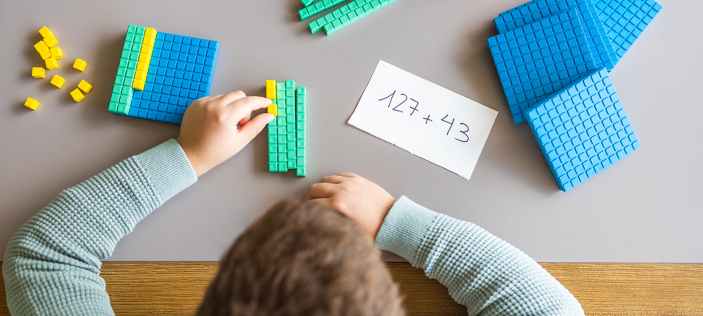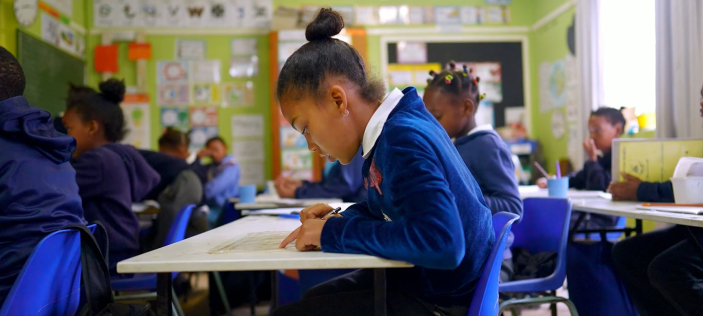In the summer term of 2021, the Herts for Learning maths team had the pleasure of working with over 130 schools across Hertfordshire and beyond as part of our Summer Success in Maths Project.
Diagnostic assessments were used to identify gaps in learning, informing how teachers would plan to teach and secure specific prerequisite skills and knowledge to prepare children for their new year group in the autumn term.
Data shared within the project provided a good oversight of strengths and weaknesses across the participating schools. More details about the findings from the project are shared in the blog, ‘Coming back stronger in mathematics’.
An interesting aspect stood out for us when analysing the data from Year 5 and Year 6 children – the children’s use of division strategies. Of course, this blog is not aimed solely at these year groups – strategies for division begin before UKS2.
So… to division.
Division is a concept which often stirs maths anxiety into both adults and children. Yet, as Rachel Rayner points out in her blog, ‘Divide and conquer: Do we share or do we group?’ , division is perhaps given less space in the maths curriculum than addition, subtraction and multiplication.
Let me put you on the spot (sorry!). How would you solve the following division calculations? If appropriate, how might the children in your class tackle them?
- 84 ÷ 6
- 1872 ÷ 6
I wonder if you used formal calculation strategies as below, where short division has been used to find the quotient in each calculation.


Or perhaps you used an informal method by using mental methods and perhaps jottings?
In a previous blog, ‘Old maths vs new maths – the balancing act’, we explored how using ‘newer’ methods may make calculations easier and more manageable – and we will explore this idea again here.
Let’s take the first calculation – 84 divided by 6.
Is using short division the most efficient method for this calculation? If a Year 4, Year 5 or Year 6 pupil used this method, it would be worth considering how secure pupils are with connecting their knowledge of multiplication and multiples to division.
You might consider the following:
- do pupils look closely at the numbers involved before deciding on a calculation strategy?
- how confident are pupils with regrouping numbers flexibly and can they see the usefulness of this strategy for this calculation?
- are pupils really secure with the value of the digits in the number or are they following a procedure to solve the calculation?
It could be argued that the most efficient way to tackle this calculation is to look for the multiples of 6 within 84. We might be hoping to hear or see the following from pupils:
- I know that it is greater than 10 groups of 6 as 10 groups of 6 is 60. 60 and 24 is equal to 84
- we could regroup 84 into useful multiples of 6
- 60 is a multiple of 6 and so is 24
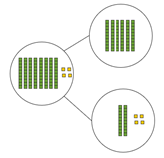
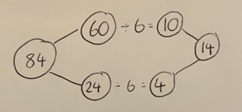
Within the Year 5 and Year 6 diagnostics, we wanted to assess whether pupils understood that regrouping numbers to divide is a useful strategy. The results made for interesting reading.
In the early summer term Year 5 paper, pupils were given the following question:
When dividing 98 by 7, which would be the most helpful way to regroup 98 to aid the calculation?
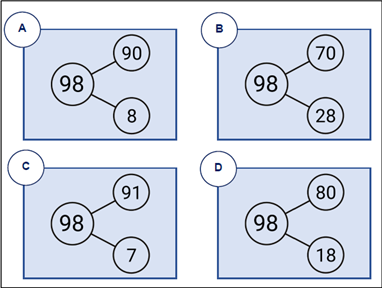
Can you guess which answer might have been the most popular choice?
Only 30% identified that the most useful regroup to divide 98 by 7 would be 70 and 28 – 70 divided by 7 and 28 divided by 7.
42%, however, chose response A.
20% chose C.
4% chose D.
4% did not respond.
This was out of 1,253 pupils across Hertfordshire schools.
Of course, all the part whole models show regroups of 98, and although answer C is regrouped into multiples of 7, they are arguably less helpful than the regroups of 70 and 28 which are likely to allow known facts to be used.
In the end of term Year 6 paper, pupils tackled a similar question:
Nadia is dividing by 9 using a mental method.
Which of these regroups for 297 would be most useful?
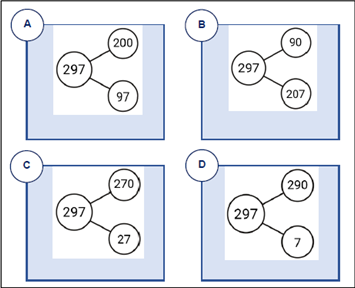
Only 29% of children (of the 566 in this data set) accurately identified that 270 and 27 were the most useful regroups of 297 in this case.
Again, the most popular response was answer A, with 36% of the children regrouping into hundreds and tens and ones without recognising that neither 200 nor 97 are multiples of 9.
Pupil scores showed more confidence with the following 2 questions:
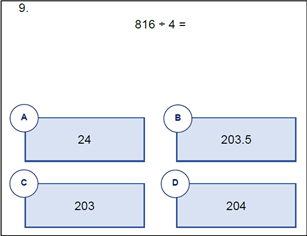
72% of 1,253 Year 5s correctly identified 204 as the quotient.
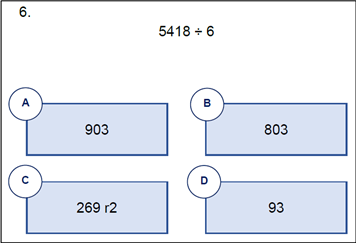
Out of 1,054 year 6 pupils, 78% correctly identified 903 as the quotient.
It would be interesting to know how many children reverted to a formal written method to solve these questions rather than really looking at the numbers within each dividend.
Much like the calculation I posed towards the start of the blog, 1872 ÷ 6, the numbers within the calculation have been carefully chosen. Within these dividends are common multiples of the divisors. What we are aiming for here is securing understanding of regrouping as well as the use of base facts and place holders if required.
For example, for 816 ÷ 4:
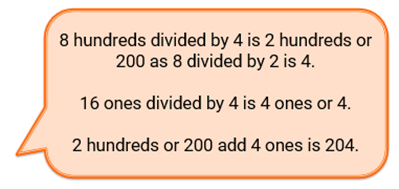
Again, a written method is not necessarily needed but may be the default method for many of our children and these can be prone to error if children lack true understanding of ‘the procedure’.
Regrouping for division may not be such a ‘new’ calculation method. Let’s consider the ‘chunking’ method of division – chunking off multiples of 10 and subtracting these from the dividend until a number less than a multiple of 10 was left. Really, this is what we are doing when we are regrouping but this is just much more efficient.
So how could we expose and encourage this strategy with pupils in KS2?
Here is a possible suggestion of small steps. The examples could be adapted for use in lower key stage 2.
- Begin by asking pupils to regroup a number in multiple ways using base-10 or place value counters. Pupils could be encouraged to represent regroups pictorially through part whole models.

- Following this exploration, the calculation 105 ÷ 3 is introduced. The multiple ways of regrouping 105 can then be revisited asking pupils which would be most useful for the calculation and why. Pupils may respond with the following:
- ’90 and 15 are both multiples of 3.’
- ‘ I know that 90 is a multiple of 3 because 9 is a multiple of 3. 90 is ten times greater than 9’
- ’30, 30, 30 and 15 could be useful regroups as they are multiples of 3.’
All contributions are valuable and can then be further discussed.
- A recording scaffold such as the following example can then be used for pupils to explore calculations and question prompts such as:
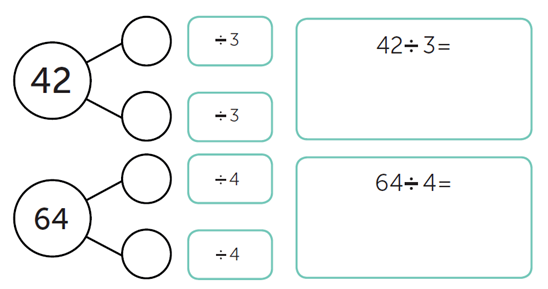
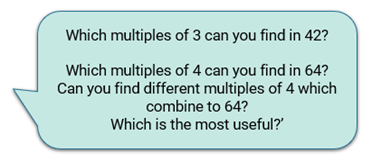
- explore further examples with pupils choosing their most useful regroups
- useful regroups could be provided with pupils asked to use the given information to solve the calculation such as in this destination question:
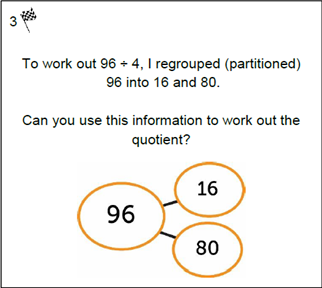
The data collected in the summer doesn’t tell us that pupils cannot regroup numbers but perhaps it suggests that they are less confident with flexible regrouping (this learning starts in KS1) and with the knowledge of why we might want to use regrouping as a strategy for division – to make the calculation easier and more manageable.
Perhaps children can get a little hung up on the apparent sophistication of ‘complex’ methods when, why wouldn’t we want to make things easier for ourselves!
Moreover, by truly understanding and being able to manipulate the numbers in front of us - by creating useful regroups if appropriate for example – is actually perhaps a more sophisticated way of solving calculations.
References:
Questions and models from ESSENTIALmaths.

